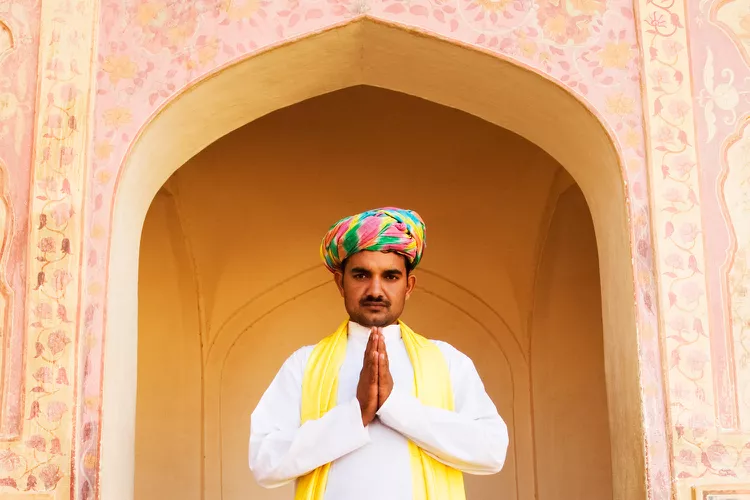Summary
Over a thousand languages are spoken across the Indian subcontinent, but fortunately, we only need to learn one way to say hello in Hindi: Namaste.
There’s a good chance that what you’re hearing at home is a slight mispronunciation of the now-widespread greeting. Here’s a clue: “nah-mah-stay” isn’t completely proper. Whether you correct people in yoga class or not is entirely up to you.
Standard Hindi and English are considered the two official languages in India. English is so prevalent, the amount of Hindi you learn while traveling in India is really a matter of how much effort you want to put into it.
As in any country, learning the greetings and a few words increases positive interactions. A bit of effort will greatly enhance your grasp of the culture. Learning the right way to say hello in Hindi isn’t a problem. Mastering the Indian head wobble, on the other hand, might be a different story.
Saying Hello in Hindi
The most common, universal greeting to use in India and Nepal is namaste (sounds like “nuhm-uh-stay”).
Greetings in India are not based on the time of day. A simple namaste will do for all occasions day or night. Put your hands together in the pranamasana gesture for added respect.
Although namaste began as a way to show deep respect, it is now used as a common greeting between strangers and friends of all age and status. In some circumstances, namaste is also used as a way to express sincere gratitude.
Namaskar is another common Hindu greeting that is used interchangeably with namaste. Namaskar is often used in Nepal when greeting elders.
How to Pronounce Namaste the Right Way
Although saying namaste to others has become a bit of a trend outside of India, it is often spoken incorrectly. Don’t worry: There’s very little chance of an Indian person correcting your pronunciation when you are trying to offer a polite greeting.
The pronunciation of namaste differs slightly throughout India, but the first two syllables should be pronounced with more of an “uh” sound than an “ah” sound as often heard in the West.
“Nah-mah-stay” is the most common incorrect pronunciation of namaste. Instead of visualizing “nah” to begin the word, think of “num” instead and the rest will flow. The second syllable simply sounds like “uh,” then finish the word with “stay.”
Use roughly the same emphasis on each syllable. When spoken at natural speed, the difference is hardly discernible.
The Pranamasana Gesture
A friendly namaste greeting is often accompanied by a prayer-like gesture known as the pranamasana. The palms are placed together similarly but a little lower than the wai that is used in Thailand. The hands should be in front of the chest, fingertips up, symbolically above the heart chakra, with the thumbs lightly touching the chest. A very slight bow of the head shows additional respect.
What Does Namaste Mean?
Namaste comes from the two Sanskrit words: namah (bow) te (to you). The two are joined to literally form “I bow to you.” The “you” in this instance is the “real you” inside — the divine.
The first part of the greeting — na ma — loosely means “not me” or “not mine.” In other words, you are reducing your ego or putting yourself second to the person with whom you are greeting. It’s like a verbal bow.
The Indian Head Wobble
The famous Indian head wobble is neither easy to perform nor interpret for Westerners initially, but it sure is fun! It’s also addictive. An enthusiastic conversation is often accompanied by lots of wobbling from both parties.
The head wobble is sometimes mistaken by first-time travelers in India as a shake of the head to indicate “no” or “maybe,” but the meaning is actually more often a type of affirmative.
From acknowledgment to gratitude, the uniquely Indian gesture is used to convey many nonverbal ideas:
- “OK, fine”
- “I understand what you are saying”
- “I agree”
- “Yes”
- “Thank you”
- “I am acknowledging your presence”
- “Nice to see you”
- “Sure, whatever”
The head wobble is used as a silent way to say hello in India. It is also used as a courtesy to acknowledge another’s presence.
For instance, a busy waiter may wobble his head when you’ve entered a restaurant to indicate that he will be with you in a minute. You may also receive a head wobble just after you’ve asked if something from the menu is available or if a certain request is possible.
A head wobble may be the closest thing to a “thank you” that you’ll receive in parts of India. Expressing verbal gratitude to another person isn’t as common as it is in the West.
The meaning of the Indian head wobble depends entirely on the context of the situation or question asked. The more enthusiastic the head wobble, the more agreement shown. A slightly slower, more deliberate wobble along with a warm smile is a sign of affection between friends.
Although the head wobble is used throughout the subcontinent, it tends to be more prevalent in the southern states than in northern places closer to the Himalayas.





